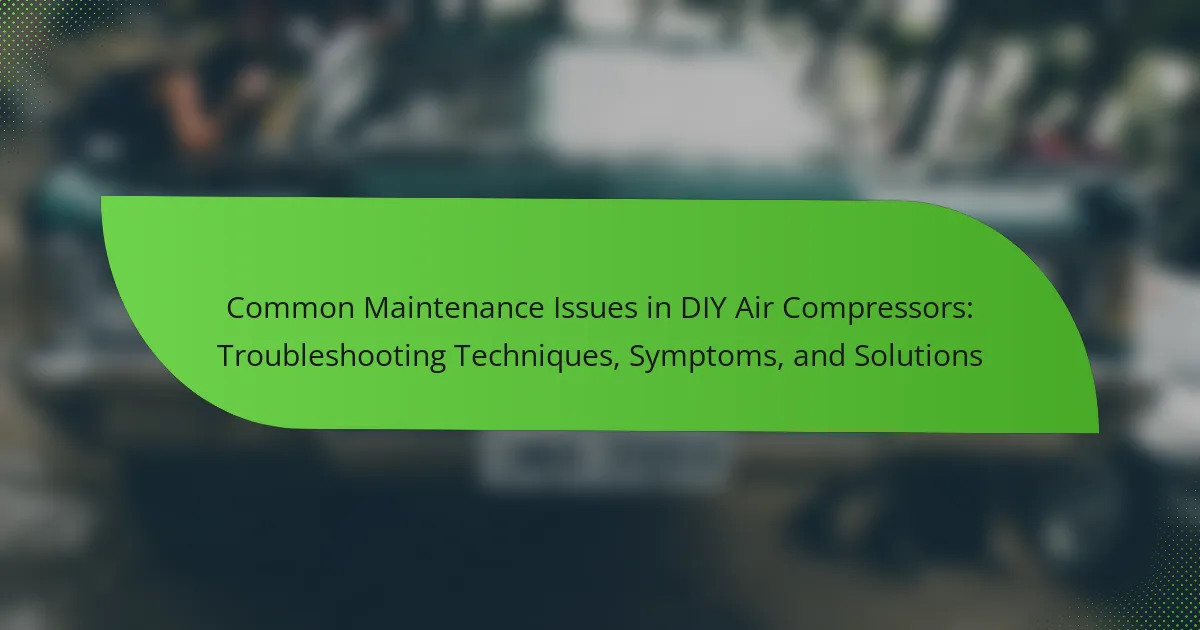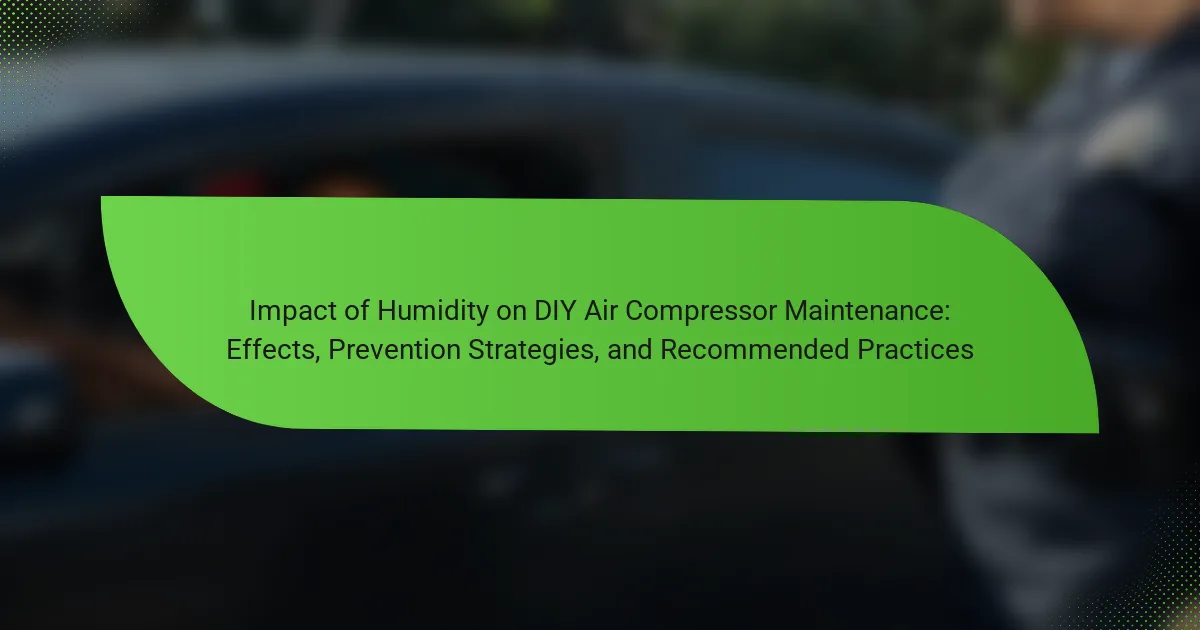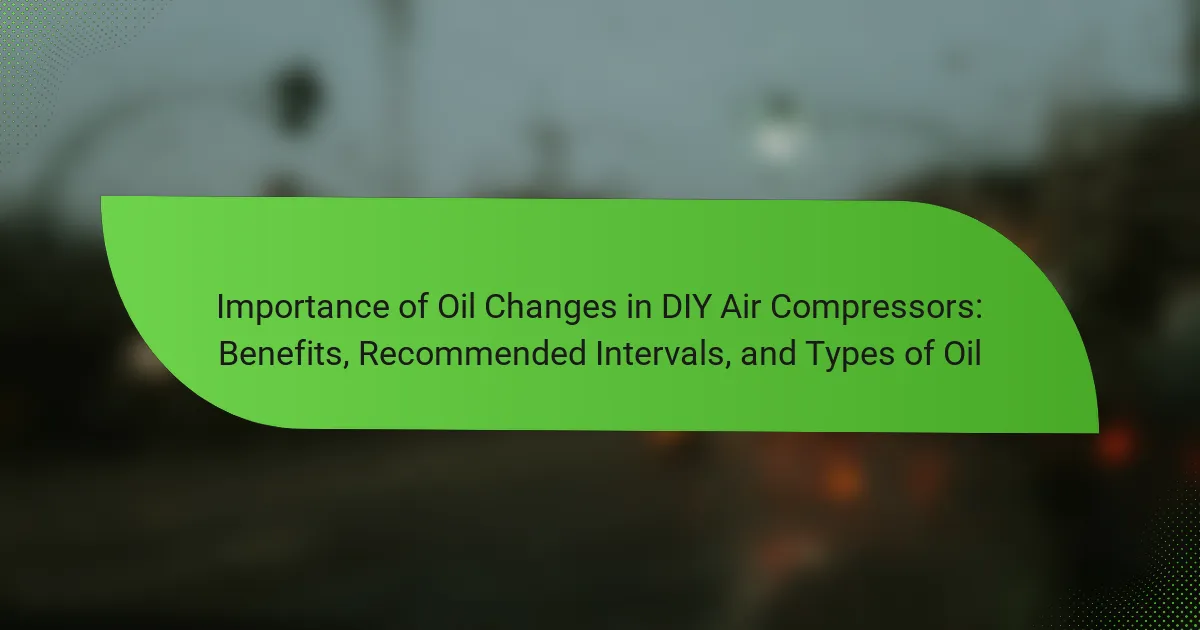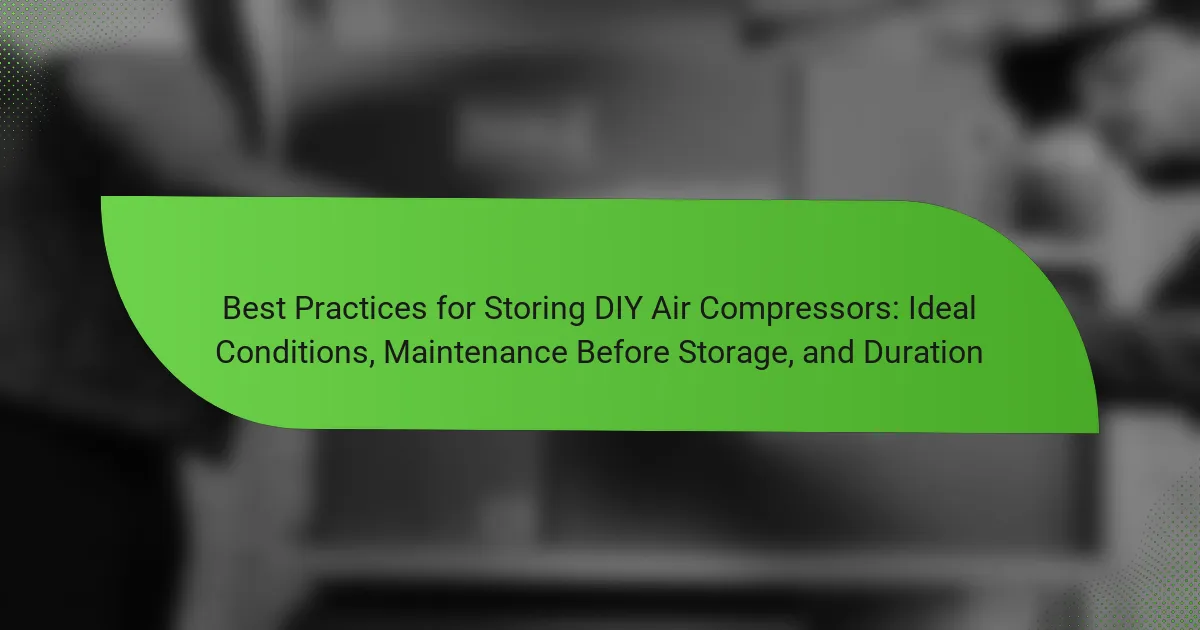A pressure regulator is a crucial component in DIY air compressors, responsible for controlling the output pressure of compressed air to ensure consistent and safe levels for tools and equipment. This article provides essential information on maintaining pressure regulators, including identifying signs of wear such as fluctuating pressure readings and air leaks. It offers detailed guidance on adjusting the pressure regulator for optimal performance, using a pressure gauge for accuracy. Additionally, it emphasizes the importance of regular maintenance and outlines when to replace the pressure regulator to maintain safety and efficiency in air compressor systems.
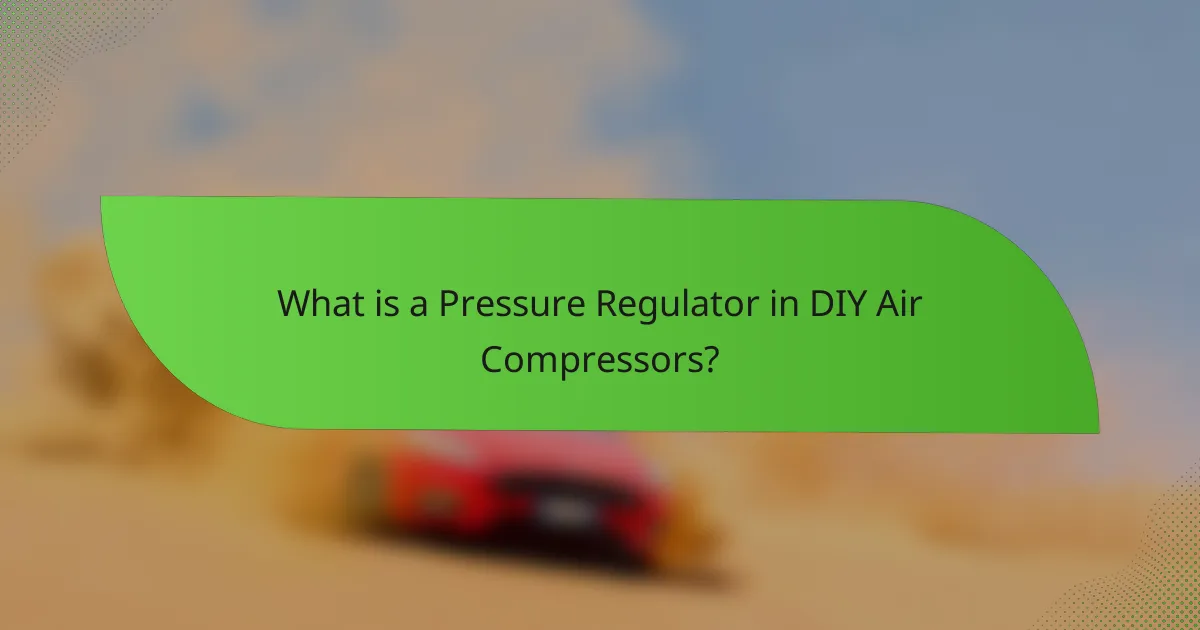
What is a Pressure Regulator in DIY Air Compressors?
A pressure regulator in DIY air compressors is a device that controls the output pressure of compressed air. It ensures that the air delivered to tools and equipment remains at a consistent and safe pressure level. This regulation helps prevent damage to tools and improves their performance. Pressure regulators typically include an adjustable knob for setting desired pressure levels. They often feature a gauge to display the current output pressure. Properly functioning pressure regulators enhance the efficiency of air compressors. Regular maintenance is essential to ensure accurate pressure control. Signs of wear may include fluctuating pressure readings or air leaks.
How does a pressure regulator function in an air compressor?
A pressure regulator in an air compressor controls the output pressure of the compressed air. It maintains a consistent pressure level regardless of fluctuations in the supply pressure. The regulator uses a diaphragm that responds to changes in pressure. When the output pressure exceeds the set level, the diaphragm moves to reduce the airflow. Conversely, when the pressure drops, it allows more air to flow through. This automatic adjustment ensures the air tools receive the correct pressure for optimal performance. Properly functioning pressure regulators enhance efficiency and extend the lifespan of air tools.
What are the key components of a pressure regulator?
The key components of a pressure regulator include the inlet and outlet ports, the diaphragm, the spring, and the adjustment screw. The inlet port connects the regulator to the high-pressure source. The outlet port delivers regulated pressure to the downstream system. The diaphragm senses the outlet pressure and moves in response to pressure changes. The spring provides resistance against the diaphragm’s movement, maintaining a set pressure. The adjustment screw allows users to change the spring tension, thus adjusting the output pressure. Each component plays a critical role in ensuring accurate pressure regulation.
How do these components interact to maintain pressure?
The components of a pressure regulator interact to maintain pressure by balancing the inlet and outlet pressures. The diaphragm senses the outlet pressure and adjusts the valve position accordingly. When outlet pressure drops, the diaphragm moves, opening the valve to allow more air in. Conversely, if the outlet pressure exceeds the setpoint, the diaphragm closes the valve. This dynamic feedback loop ensures consistent pressure delivery. Additionally, the spring tension determines the pressure setting, influencing how the diaphragm responds. Regular maintenance of these components is crucial for optimal performance. Proper adjustment and timely replacement of worn parts enhance reliability.
What are the signs of wear in a pressure regulator?
Signs of wear in a pressure regulator include visible leaks, inconsistent pressure readings, and unusual noises during operation. Leaks may occur at the seals or fittings, indicating deterioration. Inconsistent pressure readings suggest internal wear or malfunction. Unusual noises, such as hissing or rattling, can indicate component failure. Additionally, the presence of rust or corrosion on the regulator’s exterior can signal potential internal damage. Regular inspection for these signs is crucial for maintaining optimal performance.
How can you identify a malfunctioning pressure regulator?
A malfunctioning pressure regulator can be identified by several key signs. First, check for inconsistent pressure readings on the gauge. Fluctuating or erratic readings indicate potential issues. Second, listen for air leaks around the regulator. Hissing sounds typically signify a leak. Third, observe the air flow. Insufficient or excessive air output can suggest malfunction. Fourth, inspect for physical damage. Cracks or corrosion on the regulator body can impact performance. Lastly, monitor the system’s performance. If tools or equipment are not operating effectively, the regulator may be at fault. Regular checks can help in early identification of these issues.
What are the common symptoms of wear and tear?
Common symptoms of wear and tear include reduced performance and efficiency. Users may notice air leaks around the pressure regulator. There can be visible signs of corrosion or rust on the metal components. Additionally, unusual noises may indicate internal damage. The regulator may also exhibit erratic pressure readings. Frequent adjustments may be required to maintain consistent operation. These symptoms collectively suggest that the pressure regulator is experiencing wear and tear. Regular inspections can help identify these issues early.
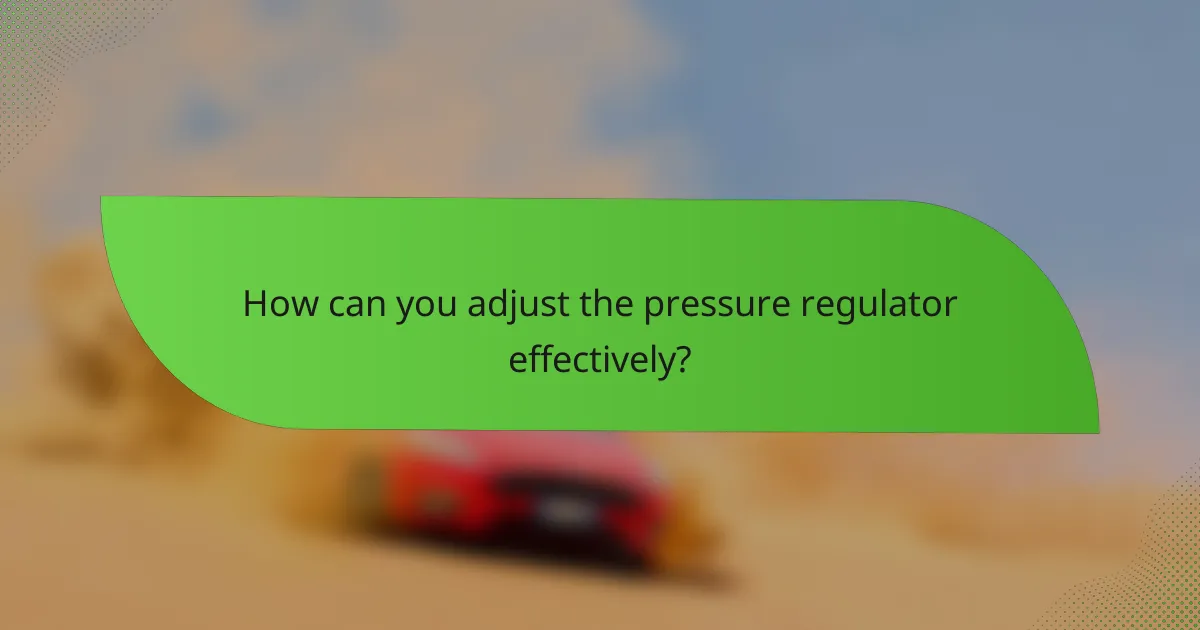
How can you adjust the pressure regulator effectively?
To adjust the pressure regulator effectively, first, identify the adjustment screw on the regulator. Turn the screw clockwise to increase pressure and counterclockwise to decrease pressure. Use a pressure gauge to monitor changes accurately. Make small adjustments and wait for the system to stabilize. Check the pressure gauge after each adjustment to ensure desired levels are reached. Repeat the process until the correct pressure is achieved. This method ensures precise control over the output pressure of the air compressor system.
What steps should you follow to adjust the pressure regulator?
To adjust the pressure regulator, first, turn off the air compressor. Next, release any air pressure in the system by opening a valve. Locate the adjustment knob or screw on the pressure regulator. Turn the knob or screw clockwise to increase pressure and counterclockwise to decrease it. After making the adjustment, turn the air compressor back on. Monitor the pressure gauge to ensure it reaches the desired level. Repeat adjustments if necessary until the correct pressure is achieved. These steps ensure proper functioning of the pressure regulator in DIY air compressors.
How do you determine the correct pressure settings?
To determine the correct pressure settings for a pressure regulator, consult the manufacturer’s specifications. These specifications provide the recommended pressure range for optimal performance. Measure the current pressure using a reliable gauge. Adjust the regulator to align with the specified range. Check the pressure output after adjustments to ensure accuracy. Verify that the air compressor operates effectively within this range. Regularly monitor the pressure settings to maintain consistent performance. Accurate pressure settings enhance the efficiency and lifespan of the air compressor.
What tools are needed for adjustment?
To adjust a pressure regulator in a DIY air compressor, specific tools are required. A flathead screwdriver is essential for turning adjustment screws. A wrench is needed to secure or loosen fittings. A pressure gauge is important to monitor the pressure during adjustment. Additionally, pliers may be useful for gripping small parts. These tools ensure accurate and effective adjustments. Proper adjustment can prevent compressor malfunction and extend its lifespan.
Why is regular adjustment important for maintenance?
Regular adjustment is important for maintenance to ensure optimal performance of the pressure regulator. Proper adjustments help maintain consistent pressure levels, preventing equipment damage. Regular adjustments can also extend the lifespan of the regulator by reducing wear and tear. According to industry standards, improper pressure can lead to inefficient operation and increased energy consumption. Maintaining correct settings ensures safety and reliability in air compressor systems. Regular checks can identify issues before they escalate, saving costs on repairs.
How does proper adjustment affect compressor performance?
Proper adjustment enhances compressor performance by optimizing its efficiency and output. When correctly set, the pressure regulator ensures the compressor operates within its designed pressure range. This prevents energy wastage and reduces wear on components. Additionally, proper adjustment minimizes the risk of overheating, which can lead to mechanical failures. Studies show that compressors maintained at ideal pressure settings can achieve up to 20% greater efficiency. Regular adjustments also prolong the lifespan of the compressor by reducing strain on the motor and other parts. Thus, proper adjustment is crucial for maintaining effective and reliable compressor operation.
What risks are associated with improper settings?
Improper settings on a pressure regulator can lead to equipment damage and safety hazards. High pressure can cause hoses and fittings to burst, resulting in injuries. Low pressure may lead to inadequate performance of air tools, causing inefficiency. Additionally, incorrect settings can result in air leaks, wasting energy and increasing operational costs. Regularly checking and calibrating settings prevents these risks. According to safety standards, maintaining proper pressure levels is crucial for safe operation.
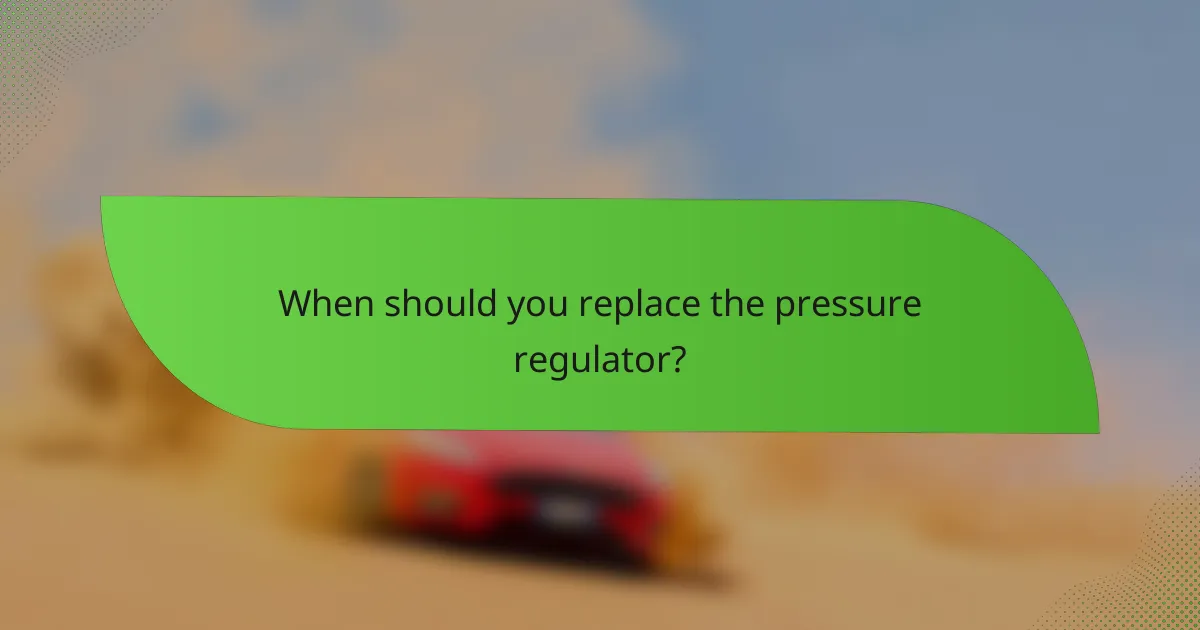
When should you replace the pressure regulator?
Replace the pressure regulator when it shows signs of wear or malfunction. Common indicators include inconsistent pressure readings and air leaks. If the regulator does not adjust pressure as needed, replacement is necessary. Additionally, if the regulator is over five years old, consider replacing it as a precaution. Regular maintenance can prolong its life, but eventual replacement is unavoidable. Always ensure safety and efficiency by monitoring the regulator’s performance.
What factors indicate that replacement is necessary?
Signs that indicate replacement is necessary for a pressure regulator include leaks, inconsistent pressure readings, and physical damage. Leaks occur when there is visible air escaping from the regulator. Inconsistent pressure readings can lead to poor performance in air tools. Physical damage may manifest as cracks or corrosion on the regulator body. Additionally, a significant drop in performance or efficiency during operation suggests that replacement is required. Regular inspection can help identify these issues early, ensuring optimal functionality of the air compressor system.
How does age affect the performance of a pressure regulator?
Age negatively affects the performance of a pressure regulator. Over time, internal components can wear down, leading to reduced accuracy in pressure control. Aging can also result in the degradation of seals and diaphragms. This degradation may cause leaks, affecting the regulator’s efficiency. Additionally, corrosion can occur, particularly in metal components, further diminishing functionality. Regular maintenance is essential to mitigate these effects. Signs of aging include inconsistent pressure readings and visible wear. Replacing aging regulators is crucial for optimal performance in air compressors.
What are the signs that a regulator is beyond repair?
Signs that a regulator is beyond repair include visible damage or corrosion. A malfunctioning regulator may also leak air continuously. Additionally, inconsistent pressure readings indicate potential failure. If the regulator cannot maintain set pressure, it may be damaged. Unusual noises during operation can signal internal issues. Frequent adjustments without stable performance suggest irreparable wear. Lastly, age and prolonged use can lead to total failure. Regular inspection can help identify these signs early.
How do you replace a pressure regulator in a DIY air compressor?
To replace a pressure regulator in a DIY air compressor, first, disconnect the power supply. This ensures safety while working on the compressor. Next, locate the pressure regulator, which is usually attached to the air tank. Use a wrench to unscrew the regulator from its fittings. Carefully remove any attached hoses or pipes to avoid damage. Install the new pressure regulator by reversing the removal steps. Secure it tightly to prevent air leaks. Finally, reconnect the power supply and test the compressor for proper operation. Following these steps ensures a successful replacement of the pressure regulator.
What are the step-by-step instructions for replacement?
To replace the pressure regulator in a DIY air compressor, first, disconnect the power supply. This ensures safety during the process. Next, relieve any air pressure from the tank. Open the drain valve to release trapped air.
Afterward, locate the pressure regulator on the compressor. Use a wrench to unscrew the regulator from its mounting. Carefully remove any attached hoses or fittings.
Install the new pressure regulator by reversing the removal steps. Securely attach the hoses and fittings to the new unit. Finally, tighten the regulator in place and close the drain valve. Reconnect the power supply and test the compressor for proper operation.
What safety precautions should you take during replacement?
Wear safety goggles to protect your eyes during replacement. Gloves should be worn to prevent cuts and chemical exposure. Ensure the air compressor is unplugged before starting the replacement process. Release any remaining pressure from the tank to avoid accidents. Use tools that are in good condition to ensure safety and efficiency. Work in a well-ventilated area to avoid inhaling harmful fumes. Follow the manufacturer’s instructions for the replacement procedure closely. These precautions help prevent injuries and ensure a safe working environment.
What are the best practices for maintaining a pressure regulator?
Regularly inspect the pressure regulator for leaks or damage. Check the fittings and connections for tightness. Clean the regulator to remove dust and debris. Replace filters as needed to ensure proper airflow. Test the regulator’s pressure settings periodically for accuracy. Lubricate moving parts according to the manufacturer’s guidelines. Monitor for unusual noises or fluctuations in pressure. Follow the manufacturer’s maintenance schedule for optimal performance.
How can regular checks prolong the lifespan of a pressure regulator?
Regular checks can prolong the lifespan of a pressure regulator by identifying issues early. Routine inspections help detect leaks, corrosion, or wear. Addressing these problems promptly prevents further damage. Regular maintenance ensures that all components function correctly. This includes verifying pressure settings and ensuring seals are intact. Studies show that consistent maintenance can extend equipment life by 20-30%. By maintaining optimal conditions, pressure regulators operate more efficiently. This reduces the risk of failure and costly replacements. Regular checks ultimately enhance the reliability of the pressure regulator.
What maintenance schedule should you follow for optimal performance?
For optimal performance of a pressure regulator in DIY air compressors, follow a maintenance schedule that includes monthly inspections and annual servicing. Inspect the regulator for leaks, corrosion, and wear every month. Clean the regulator’s exterior and check the pressure gauge functionality during these inspections. Replace any damaged parts immediately to prevent performance issues. Perform a more thorough servicing annually, which should include disassembling the regulator for internal cleaning and lubrication. This schedule ensures longevity and efficiency. Regular maintenance minimizes the risk of failure and enhances overall compressor performance.
The main entity of this article is the pressure regulator in DIY air compressors, a crucial device that controls the output pressure of compressed air. The article provides a comprehensive overview of the pressure regulator’s function, key components, and the importance of regular maintenance and adjustments for optimal performance. It highlights signs of wear, symptoms of malfunction, and guidelines for effective adjustment and replacement. Additionally, it outlines best practices for maintaining the pressure regulator to ensure safety and efficiency in air compressor operation.
